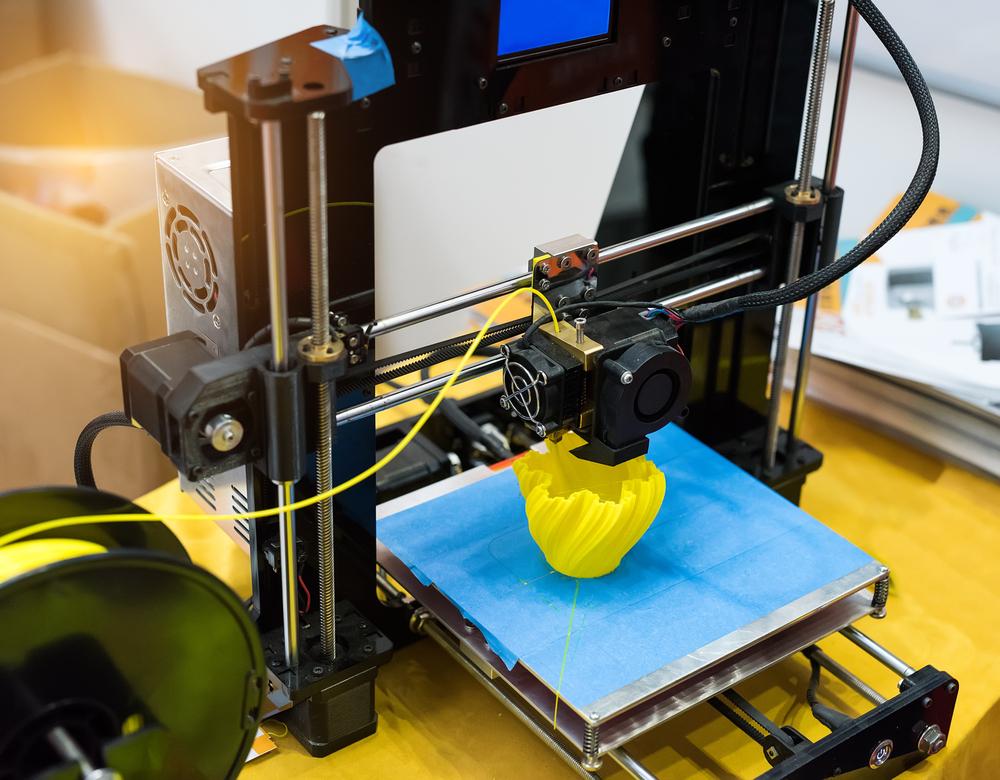Business News Daily provides resources, advice and product reviews to drive business growth. Our mission is to equip business owners with the knowledge and confidence to make informed decisions. As part of that, we recommend products and services for their success.
We collaborate with business-to-business vendors, connecting them with potential buyers. In some cases, we earn commissions when sales are made through our referrals. These financial relationships support our content but do not dictate our recommendations. Our editorial team independently evaluates products based on thousands of hours of research. We are committed to providing trustworthy advice for businesses. Learn more about our full process and see who our partners are here.
9 Cool 3D Printing Jobs
Knowing your way around a 3D printer could help you find a job.

Table of Contents
Former President Barack Obama once said 3D printing has the “potential to revolutionize the way we make almost everything.” If you aren’t using the technology yet, know that plenty of people are already using it across a number of sectors. 3D printing had a global market size of $16.8 billion in 2022, according to Grand View Research. By 2030, that number is expected to hit more than $72 billion.
As the 3D printing industry booms, what does this mean for job seekers? There are many career opportunities that have been created or are getting a boost from the popularity of 3D printing. But there are also pros and cons to consider before pursuing one.
What is 3D printing?
Rather than using ink and paper, a 3D printer uses materials like plastic, metal or ceramic to create a 3D model. By using computer-aided design (CAD) files as digital instructions to create an object, a 3D printer repeatedly covers a work surface with layers of material in precisely the right spots to create a structure from scratch.
While 3D printing can be used for large-scale structures, it’s most helpful in creating smaller, customized parts or prototype components for various uses, including automotive engineering and the medical industry. With the versatility of 3D printing, it’s a field filled with opportunities. [Read related article: 3D Printing Applications for Business]
3D printing jobs
The possibilities for working with 3D printing are practically limitless. Consider these nine jobs if you’d like to take your career in this direction.
1. 3D design
3D printing relies heavily on designers who can take a product idea and bring it to life. Thanks to its growth, 3D printing is creating jobs for 3D designers at 3D printing firms and in other companies as part of creative teams and as freelancers.
3D printers are being used in many design disciplines, such as product design, medical device design, architectural visualization and entertainment design, said Erol Gunduz, a former professor at New York University’s School of Continuing and Professional Studies (NYU-SCPS), which offers programs in 3D printing, design and modeling.
To be competitive, job seekers should gain hands-on experience in 3D technologies and stay current on how companies are using 3D printing. For instance, recent graduate student designers and researchers who are familiar with 3D printing methods have the benefit of knowing how to use the technology within their design process, Gunduz explained.
“This gives them a significant advantage when looking for career opportunities within creative fields,” Gunduz said.
Salary range: $41,600 per year to $99,840 per year
2. 3D CAD modeling
3D printing would not be possible without CAD experts who have the skills to convert product designs into digital blueprints that the printers need to fabricate items. Along with product designers, there is a demand for 3D CAD modelers.
“I see a lot more demand for CAD and 3D modeling jobs on the horizon because of 3D printing,” said Alex English, former owner of ProtoParadigm.
Although 3D CAD professionals are also needed to construct models for mass 3D printing, they are especially important for custom products.
“Bespoke manufacturing and custom prototyping both rely on the user’s ability to conceptualize the object they want and accurately create its digital representation,” English said.
Consequently, 3D CAD modeling jobs require printing-specific modeling skills, such as feature size, geometrical constraints and knowledge of materials, English added.
Salary range: $54,733 per year to $71,548 per year
3. Research and development
3D printing is all the buzz but not just in the gadget world. Just as the growing 3D printing industry requires more product designers and CAD modelers, jobs are opening up for forward-thinking research and development professionals who understand the intersection of tech and consumer products.
“While 3D visualization technologies have been used in the past within various fields, such as engineering and scientific agendas, many artistic and consumer product industries, such as fashion design and jewelry design, are beginning to take advantage of 3D printing systems,” Gunduz said.
Companies need people who can find the best way to utilize 3D printing for consumer products at the lowest cost possible.
“The ability to visualize a line of fashion accessories or jewelry designs before committing to working with expensive materials affords an advantage for companies to reduce costs in development cycles,” Gunduz said.
Salary range: $82,000 per year to $146,000 per year
4. Biological and scientific modeling
3D printing is not limited to consumer products; it can create many items that promote medical advancement and save lives. It can also create drone and defense equipment and possibly even space food.
Accordingly, the 3D printing industry needs more engineers, designers and modelers who have a biomedical or scientific background to innovate further and produce highly advanced 3D-printed products.
“While all manner of designers will be able to print the things they design, there will be a high end to the market — particularly in medical, aerospace, military and other high-precision or mission-critical applications — for those that better understand the printing technologies and how to design for their strengths and limitations,” English said.
Salary range: $70,650 per year to $173,000 per year
5. Architecture and construction modeling
3D printing is disrupting various industries, particularly those that rely heavily on blueprinting or prototyping. For the construction industry, this paradigm shift has boosted the need for 3D modelers that can replace current 2D construction planning solutions.
“In the architecture, engineering and construction industries, 3D printing will redefine the production of construction documents,” said Lira Luis, the principal architect at Atelier Lira Luis LLC, a Chicago-based architecture and design firm.
Instead of 2D CAD modeling on paper, 3D printing can produce true-to-life models to better represent what structures will look like.
“As the 3D printing process becomes more streamlined, it could potentially eliminate the need for construction documents and move directly to printing full-scale mock-ups prior to construction of structures,” Luis said.
Salary range: $77,289 per year to $107,000 per year
6. Education
What good are these 3D printing jobs if no one has the qualifications to fill them? To help close the skills gap, some schools now offer 3D printing programs at all grade levels. This opens up jobs for educators who can teach the technical and business aspects of 3D printing.
“From an educational perspective, many K-12 schools are looking to 3D printing as a point of exposure for students within the arts as well as scientific areas of study,” Gunduz said.
Colleges and universities are also launching 3D printing courses and certificate programs, such as NYU-SCPS’s certificate in 3D printing rapid prototyping. The teachers, of course, need to have a background in the 3D printing industry. They also need specific skill sets to teach specialized courses and stay current on the latest trends.
“For educators, having an understanding of 3D modeling and 3D printing techniques will be invaluable, as the culture of [fabrication] labs is starting to gain support as an important aspect of education,” Gunduz said. “Teachers with 3D modeling and fabrication experience have a range of opportunities open to them within educational programs looking to incorporate this new technology.”
Salary range: $27,040 per year to $62,400 per year
7. Legal professionals
Here’s more evidence that 3D printing is not confined to the tech world: As a creative field, the industry is wide open to legal issues, prompting a need for more lawyers and legal professionals who specialize in intellectual property (IP) rights.
“As 3D printing technologies advance and become more widely accessible, it will be easier for infringers to create, market and sell products that infringe patents, copyrights and valuable brands,” said Julie Matthews, an IP lawyer at Lathrop GPM. “As 3D printing technologies advance, new business models will emerge in which consumer products and their component parts can be copied, modified, juxtaposed with others and produced almost anywhere.”
As a result, there is an increased need for IP enforcement actions and lawsuits, as well as expanded services to monitor for infringements, Matthews explained. Growth areas include IP ownership, scope of rights, licensing, fair use and international rights. [Learn how to avoid copyright infringement.]
Salary range: $86,000 per year to $240,000 per year
8. Startup companies
Are you thinking of starting a new business? 3D printing offers opportunities for innovation — not only in creating products but also for entrepreneurship. 3D printing spans various technical and design roles, many of which make great business ideas to support companies’ 3D printing needs.
“As 3D printing technologies advance and become readily accessible to home users, undoubtedly, this will lead to new business opportunities for individuals and companies offering on-site and remote 3D printing services, new product and industrial designers and computer-aided design specialists,” Matthews said.
With 3D printing costing between $1,999 and $3,500, anyone with 3D printing knowledge can start such a business.
Salary range: $53,000 per year to $130,000 per year
9. Administrative roles
3D printing companies don’t run on engineers and technicians alone. As the industry grows, new and established 3D printing companies need employees to keep their businesses running smoothly. This includes operations and administrative staff, analysts, finance and sales professionals and retail employees.
“The businesses that will spring up with new business models centered on 3D printing will also have a need for more common jobs that other businesses need, like marketing, clerical, shipping, etc.,” English said.
These jobs are opening up in all types of 3D printing companies, including vendors, manufacturers and retail stores.
Salary range: $76,000 per year to $140,000 per year
Pros and cons of 3D printing jobs
Like any career path, working with 3D printing has its upsides and downsides. Carefully weigh these pros and cons before making a job change.
Pros of 3D printing careers
- Cutting-edge innovations: 3D printing is capable of creating everything from massive components to industrial equipment, all the way down to microscopic pieces for biomechanical tools. If someone can design an object, they can 3D print it. All anyone needs is a little bit of imagination, which makes this an exciting field to work in.
- Customized, targeted markets: There’s an endless amount of items and devices that can be created through 3D printing. Someone could build an Etsy shop to sell simple, everyday 3D-printed items like an ashtray or desk organizer. Replicas of statues and buildings are possible, too, or bespoke, finely tuned components to help build fully functioning prosthetic limbs that help improve life for people with disabilities. With clearly defined business niches, there are great odds of achieving success.
- Wide variety of opportunities: Because 3D printing is still a relatively young industry, the entire landscape is teeming with opportunity. It’s still early enough for anyone starting a career in 3D printing to become a recognized industry titan.
Cons of 3D printing careers
- Material limitations: While 3D printing jobs do allow for metals and plastics to be used, those materials are usually very specific to particular 3D printers and intended uses. Polycarbonate plastics, metal powders and even carbon fiber are available as options for 3D printing material, but the specific grades used to fabricate an item can become scarce depending on supply chain delays and demand. That can cause business instability.
- Difficult to scale: Depending on the size of a project, a 3D printing job can take anywhere from less than one hour to more than 10 hours. Because of the time resources required for printing a single 3D object, printing dozens or hundreds of items could take more time than an organization is equipped for and can quickly become an unsustainable business model.
- Health hazards: Materials used for 3D printing projects often create fumes or may use metal powders or solvents that can be harmful to skin, requiring manufacturers to follow stringent safety protocols. Several simple procedures like exposure time limits and low-emission materials can help mitigate harmful effects but meaningful safety regulations are required.
A new frontier
3D printing presents several exciting career opportunities with uncapped potential that anyone can embark on. Whether you’ve got a deep engineering background for components and devices or you’re a CAD beginner wanting to try something new for work, 3D printing presents possibilities for anyone ripe for professional growth. Even a background with seemingly no connection to this technology, such as office management, could lead to a job with a 3D printing company. All it takes is finding the position that matches your skill set.
Source interviews were conducted for a previous version of this article.











